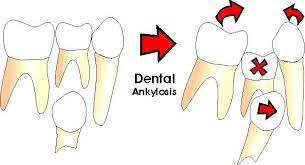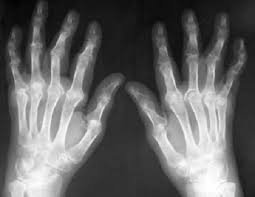What is Ankylosis?
Ankylosis is a condition in which you feel pain or rigidity in a particular joint in your body. It is also known as anchylosis. Ankylosis may be caused by injury or diseases that affect specific joints in your body.1
As a result, this leads to unusual sticking together of bones in affected joints. This condition can occur in several parts of your body such as:
- Joint in the ankle
- Joint in the knee
- Joint in the shoulder
- Joint in the finger
- Joint in the elbow
- Temporomandibular joint (TMJ)
- The spine
 Causes
Causes
There are several causes for ankylosis. They include:
Hereditary factors
Some studies show that ankylosis is as a result of defective genes passed from parent to the child. A child inherits mutated genes from the affected parents.
An example of a mutated gene is ank gene. The ank gene makes the osteoblasts overactive causing ankylosis. The ank gene is passed from infected parents to the child.
Injury
Severe physical damage to your bone may also cause ankylosis. In addition, some medical conditions such as hemophilia that cause many occurrence of bleeding in your body are also considered among the risk factors that promote ankylosis.
Rheumatoid arthritis: Diseases that affect the bone such as rheumatoid arthritis and osteoarthritis may cause ankylosis.
These diseases cause continued inflammation of the connective joint tissue, which damages chondral bone structures, synovial membrane and cartilage. As a result, there is decreased movement of connective joint leading to rigidity in that area.
Lack of exercises
If particular parts of your body remain immobile for a longer duration, it may result in abnormalities in your bone structure. For example, those individuals who spend a lot of time in bed and those who use wheelchairs are at higher risk of developing ankylosis.
Symptoms
A person with ankylosis shows symptoms such as:
- Feeling pain in the joints
- Swollen and rigid joints
- Difficult to move the joints
- Irritation in the affected areas.
Diagnosis
The first step in diagnosis of this condition is to discuss your symptoms with your doctor. Your doctor will then physically examine your joints to look for any swelling in the affected areas.
Your doctor will conduct other tests in order to diagnose you with this condition. These tests include the following:
Blood analysis
Your doctor will take a sample of your blood and analyze it in the laboratory to determine the cause of this condition. Your doctor will perform a blood sedimentation rate test to find out the extent of inflammation in your body caused by inflammatory diseases.
In this test, a sample of your blood is put in a test tube and your doctor determines the duration the red blood cells will take to reach the bottom of the test tube.
Normally, when blood is put in the test tube, red blood cells do not cluster together and take a lot of time to reach at the bottom of the tube.
On the other hand, red blood cells that have been exposed to inflammation crowd together and take the shortest time to reach at the bottom of the test tube.
Urinalysis
Urinalysis is a test performed on your urine. Your doctor may take a sample of your urine and analyze it to determine if you have a kidney disease, diabetes and an infection in the urinary tract.
In this test, your doctor may look at the content, appearance and concentration of your urine. If your urine has too much protein, then you are more likely to have a kidney disease.
Kidney disease is associated with pain in the back which is as a result of ankylosis. Urinalysis test is vital to distinguish between a kidney disease and any bone abnormality in your body.
Imaging tests
Imaging tests are very important to help your doctor find out any abnormalities in your joints and bones. The tests can also show if deposits of calcium is present in your bones.
Your doctor may use a number of imaging tests to provide detailed images of your soft joint tissues and bones such as magnetic resonance imaging (MRI), X-rays and computed tomography (CT).

Differential Diagnosis
Your doctor may also perform other tests to rule out other conditions related to ankylosis. These medical conditions include:
- Spondyloarthritis
- Vertebral inflammation
- Ankylosing Spondylitis
- Spondylitis
- Rheumatoid Spondylitis
Treatment and Prevention
Ankylosis can be healed with a good management plan which includes a physical therapy and medication. Physical therapy and medicines are vital because they help to relieve pain and rigidity in your joints.
For physical therapy, consult your physiotherapist on the best exercise to help you reduce rigidity and enhance mobility in joints. Your physiotherapist will first determine the exact place of ankylosis and severity of your symptoms.
Once this is done, the physiotherapist prepares a treatment plan to help cure your symptoms. Your physiotherapist may recommend the following exercises:
Jaw exercises
Jaw exercises are meant to relive pain in your temporomandibular joint (TMJ). Temporomandibular joint joins your jaw to bones of your skull. You can do the following exercise to ease the discomfort.
Strength building exercises
In temporomandibular joint strengthening exercise, you will open and close your mouth by placing a resistance on your chin.
For an opening exercise, place one of your thumbs below the chin and thrust softly down against it. Then gradually open your mouth while pushing and leave it open for short time and close it slowly.
For a closing exercise, maintain your thumb below the chin and use the index finger from the same hand and put the finger between your lips and the chin. Then thrust gently as you close the mouth.
Stretching exercises
You can stretch the joint and jaw to help relieve the discomfort. One way of doing this is to press the tip of your tongue until it reaches the top of your mouth and gradually open your mouth.
Relaxing exercises
You can also learn how to relax your muscles by breathing in and out. For example if you are stressed, breathe in for 10 counts and gradually breathe out.
Yoga exercises
Yoga exercises are very useful in helping treat many of the symptoms of this disorder. Yoga can be done regularly at home. Before you begin these exercises, consult your physiotherapist on the best postures you can use during the exercise to achieve maximum results.
Medications
Your doctor may recommend pain relieving medication such as asprin and anti-inflammatory drugs reduce pain in the affected areas.
Surgery
When you have unusual combination of your bones and tissues, your doctor will conduct a surgery to separate them. For temporomandibular joint anchylosis, your doctor will remove the bone in the lower jaw and replace it with prosthetic condyle.
Reference List
- Ankylosis. Available at http://www.primehealthchannel.com/ankylosis.html
- Sedimentation rate. http://www.mayoclinic.org/tests-procedures/sed-rate/home/ovc-20207006
- TMJ Exercises for Pain Relief. http://www.colgate.com/en/us/oc/oral-health/conditions/temporomandibular-disorder/article/tmj-exercises-for-pain-relief-1115
- Urinalysis. http://www.mayoclinic.org/tests-procedures/urinalysis/home/ovc-20253992
